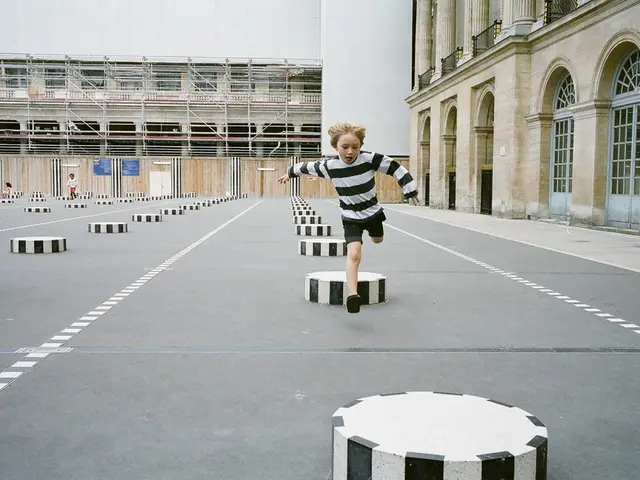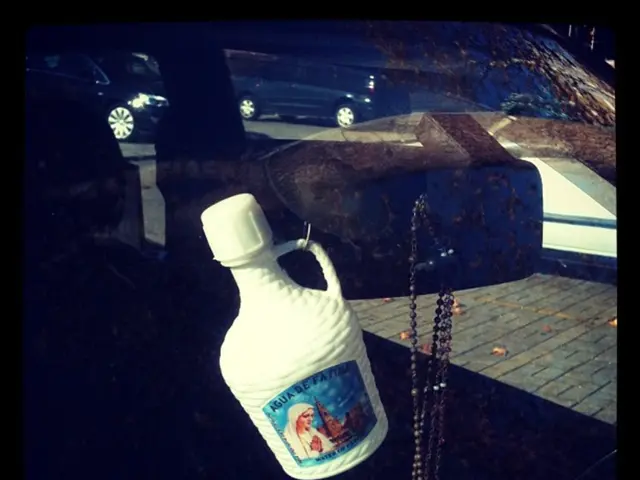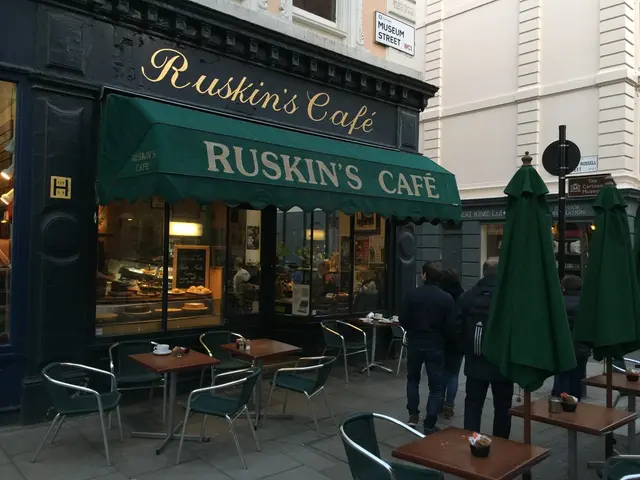Eastern Neubrandenburg: Beyond the Bounds of the GDR (Former East Germany)
In a nutshell: Ostmoderne - More Than Just Soulless Housing Blocks?
Taking a fresh perspective, let's dive into Ostmoderne, a term that, to many, might invoke images of dull prefabricated apartment blocks. Is that image truly fair? Well, read on to find out!
Milatz: Sheer beauty lies in blending East and Modern in a single word. It's quite fortuitous that this year's festival venue is situated in a city older than 777 years and holds the House of Culture and Education, which celebrates its 60th birthday. This Ostmoderne influence extends the city's charm beyond its locality. We mustn't forget the compelling features: Pre-fab construction allowed for rapid production of many apartments, and many residents were proud to call these homes their own. While uniformity can't be justified, there are unique aspects such as Ulrich Müther's city hall or the HKB with its slender tower, which hosted numerous associations in the past and today requires high rental costs.
Schmidt: Post-war rebuilding of Neubrandenburg's city center in the '50s was influenced by national tradition. However, this building, based on Iris Grund's competition design in the '60s, marked a return to modernity. We should not confine Ostmoderne solely to apartment buildings. Sure, there are many prefabricated blocks, but a basic, solid structure allows highlights to shine.
Iris Grund, Neubrandenburg's city architect from '70 to '90, is considered one of the most influential architects in the GDR. An extraordinary career?
Milatz: Iris Grund molded this city. Across East Germany, only three women held the position of city architect, one of whom was right here in Neubrandenburg. At 26, she won the competition to design the HKB, leading its construction with remarkable success.
Schmidt: She demonstrated that industrial and prefabricated construction can be faster and more efficient. Building traditional brick homes in the city center was common until then. Her vision for city planning was, among other things, ensuring a connection for new residential areas towards the center.
Could she have paved the way for the current state of women in architecture?
Milatz: Close to 54 percent of architecture students today are female. However, the proportion of self-employed female architects diminishes significantly during the family phase. The field remains predominantly male-dominated. Perhaps this varies between departments like high-rise, landscape, interior, and urban planning. Women are just as skilled, but it's underestimated.
Schmidt: In office duos like ours, males usually take center stage. Whether there is a female, feminist architecture is debatable.
Keep an eye out for the "Women in Architecture" festival program, a tribute to Iris Grund.
The Neubrandenburg calendar is packed with exciting events. Catch the dialogue event "Experience Ostmoderne - Neubrandenburg and the legacy of architect Iris Grund," lectures, witness conversations, guided tours, and the film "Sunday, … Letters from a city."
From June 20th to 28th, the Architecture Salon unfolds at Turmstraße 15, featuring a daily changing format. Explore exhibitions, contributions by Planning Women, rereading Iris Grund, discussions on diversity in the profession, presentations of Bachelor's Thesis Landscape Architecture, a club evening, and much more.
On June 26th, watch the film "Our Short Life" inspired by Brigitte Reimann's novel "Franziska Linkerhand."
And don't miss the extension building of Neubrandenburg University of Applied Sciences, showcased on June 29th, as part of the Day of Architecture. The "Women in Architecture" festival in Mecklenburg-Western Pomerania also includes city tours on the topic of "Daughters of the Hanse" in Wismar on June 19th and the film evening "E.1027 - Eileen Gray and the House by the Sea" at the Rostock Lichtspieltheater Wundervoll on June 27th.
Milatz: Born and bred East German, I was raised understanding that women should work equally. What matters is professional and human competence; it's about the functionality of a building and people feeling comfortable in it.
Milatz: Grit defines me. I was active in sports during my youth, so I can stand my ground and stay motivated. Raising two children on my own and daring to become self-employed at age 40 shows determination. One must always stay active and ambitious.
Milatz: By the political transition, I abandoned the idea of pursuing a Ph.D. because I wanted to build instead. Besides professional aspirations, my children, who were high-performance athletes, were very important to me. If I gave up anything, it was perhaps my own hobbies.
What awaits the dream job of architecture, the next generation of professionals?
Milatz: That's a broad topic. If we were to establish a new firm today, we would want to found it in a city with a degree program. It's a pity that there's no full-degree program in civil engineering in Neubrandenburg (Note from the editor: The program was discontinued in 2012, but there are two entry semesters again since 2022, with a subsequent transfer to the University of Wismar), making it crucial to bring professors from Wismar for student excursions to the region. Plus, Szczecin is theoretically not far, but impractical by public transportation. We require the full-degree program here, political support, and excursions to inspire students and graduates for us, for the region.
Is building synonymous with austerity?
Milatz: Budgets are never plenty, especially since we work predominantly for the public sector. However, private investors also have their restrictions. Our principle is honest communication from the outset regarding what's feasible.
Boasting a long list of projects, schools, town halls, churches, Wiekhaus, and residential quarters in her portfolio, is there a dream project that particularly resonates with Milatz?
Milatz: As a small firm, we've already built an impressive variety of buildings. But one project that holds deep significance for me, my childhood home in Anklam, is the conversion of the swimming pool, acquired by the sugar factory. It required heart and soul, just like many Anklammers have a strong emotional attachment to the building.
Another close-to-my-heart topic for Milatz is the "Women in Architecture" festival. What impact does she hope to achieve?
Milatz: We successfully secured four strong partners - the MV Chamber of Architects, the city of Neubrandenburg, the Neuwoges housing company, and the VZN event center. We didn't even need to concoct a fabricated theme: Ostmodernism imposes itself. The half-day opening event will feature lectures from experts in Vienna and Schwerin, intimate conversations on the green sofa, and a thought-provoking literary contribution with Brigitte Reimann's text in the film essay "Sunday, the..." - the emotions this city evokes are palpable.
Schmidt: In collaboration with colleagues, we are creating a daily changing program in an empty storefront on Turmstraße as a temporary Architecture Salon. You'll find a small exhibition and the idea of engaging in dialogue about architecture, Neubrandenburg, and planning women - we eagerly await visitors!
- The "Women in Architecture" festival, a tribute to Iris Grund, extends beyond the city's charm, touching on aspects such as fashion-and-beauty, personal-growth, and education-and-self-development.
- Milatz, a native of East Germany, values lifestyle factors, emphasizing the importance of professionals being equally competent, regardless of gender, and promoting personal-growth opportunities in cities.
- Sports, particularly football and American football, played a significant role in Milatz's youth, fostering ambition, determination, and career-development.
- Schmidt discusses the influence of Ostmoderne style on food-and-drink establishments, like the Architecture Salon, offering cultural experiences and unique venues for shopping and socializing.
- The festival program includes travel destinations, such as Wismar and Rostock, providing insights into historical and contemporary architectural design, favoring home-and-garden enthusiasts.
- Pets might not seem directly related to Ostmoderne, but the festival highlights relationships and community engagement, nurturing connections and collaborative partnerships, much like a well-loved pet.
- The city's rich history and cultural events contribute to its attractiveness for those seeking diverse experiences, making Neubrandenburg an appealing destination for travelers and car enthusiasts.
- As the next generation of architects enter the field, they will face challenges in securing education-and-self-development opportunities, especially with discontinued programs and limited resources, necessitating partnerships and political support.








